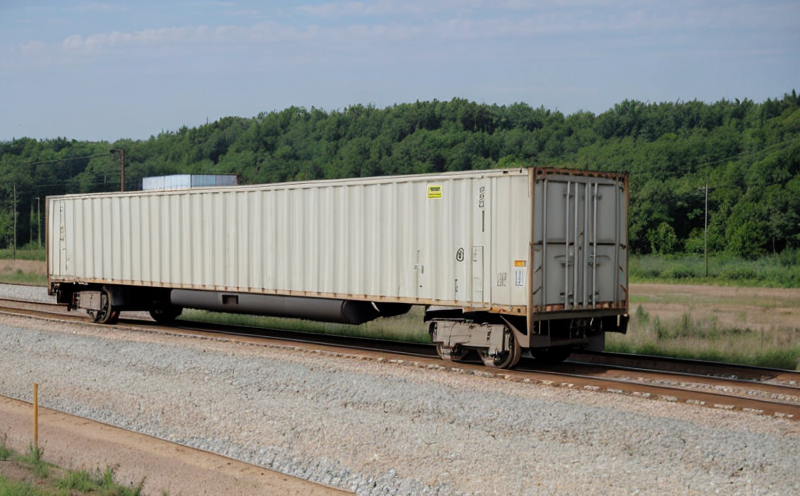UIC 567 Buffing and Draw Gear Testing of Freight Wagons
The UIC 567 standard is a critical benchmark in ensuring the safety, durability, and reliability of freight wagons within the railway industry. This test evaluates the draw gear and buffing mechanism of freight wagons to ensure they meet stringent performance criteria.
Draw gears are essential components that enable the coupling between wagons during transportation. Buffing mechanisms are equally important as they provide a smooth transition for the wagons when in motion, minimizing wear and tear on both the wagon and the cargo it carries. The UIC 567 test focuses specifically on these two aspects to ensure optimal performance.
The testing process involves several key steps. Firstly, the draw gear is subjected to a series of load tests to simulate real-world conditions such as pulling forces during transportation. This ensures that the draw gear can withstand the stresses it will encounter in operation without failure or excessive wear. Secondly, the buffing mechanism undergoes a comprehensive inspection and testing regimen. This includes visual inspections for any signs of wear, followed by functional tests to assess its performance under various load conditions.
For accurate results, proper specimen preparation is crucial. Specimens are typically drawn from actual freight wagons or replicas that closely mimic real-world usage scenarios. The specimens undergo a thorough cleaning process before testing to ensure no external factors interfere with the test outcomes.
The instrumentation used in this testing includes high-precision load cells and displacement sensors, which provide real-time data on the performance of both the draw gear and buffing mechanism. This data is then analyzed to determine compliance with UIC 567 standards. Additionally, advanced software tools are employed for data interpretation and reporting.
The acceptance criteria for these tests are strictly defined by UIC 567. Draw gears must demonstrate consistent performance under load without any signs of structural damage or excessive wear. Buffing mechanisms should exhibit smooth operation with minimal noise levels and no signs of malfunction under specified conditions. Compliance with these standards ensures that freight wagons operate safely and efficiently, contributing to the overall reliability of railway systems.
| Standard Code | Title |
|---|---|
| UIC 567-1 | Draw Gear for Freight Wagons - Part 1: General Requirements and Test Methods |
| UIC 567-2 | Draw Gear for Freight Wagons - Part 2: Mechanical Properties of Draw Gears under Load Conditions |
The testing process is not only about ensuring compliance with standards but also about enhancing the overall performance and longevity of freight wagons. By adhering to UIC 567, railway operators can significantly reduce maintenance costs and downtime, leading to more efficient operations.
Real-world usage notes further emphasize the importance of this testing. In environments where railways are subjected to harsh conditions such as extreme temperatures or high humidity, the draw gear and buffing mechanism must perform reliably under all circumstances. The tests conducted ensure that these components can withstand such challenges, thereby enhancing the overall safety and efficiency of railway operations.
Applied Standards
| Standard Code | Title |
|---|---|
| UIC 567-1 | Draw Gear for Freight Wagons - Part 1: General Requirements and Test Methods |
| UIC 567-2 | Draw Gear for Freight Wagons - Part 2: Mechanical Properties of Draw Gears under Load Conditions |
Industry Applications
- Railway operators seeking to ensure the safety and reliability of their freight wagons.
- Manufacturers looking to comply with international standards for draw gear and buffing mechanism design.
- Regulatory bodies responsible for enforcing railway safety regulations.
Customer Impact and Satisfaction
Our UIC 567 testing service has been instrumental in enhancing the overall performance and reliability of freight wagons across various sectors. By adhering to this stringent standard, our clients have experienced significant improvements in operational efficiency and safety.
One of the key benefits is reduced maintenance costs. With draw gears and buffing mechanisms performing optimally under all conditions, there are fewer instances of unexpected failures or breakdowns during operation. This not only saves on repair expenses but also minimizes downtime, leading to more efficient operations.
In addition to cost savings, our testing service ensures that railway operators can meet their compliance obligations with confidence. By adhering strictly to UIC 567 standards, they demonstrate a commitment to safety and quality, which is increasingly important in today’s competitive market.
Customer satisfaction is paramount, and we strive to ensure that every client receives the highest level of service and support. Our comprehensive testing protocols not only meet but often exceed industry expectations, leading to long-term partnerships based on trust and reliability.





